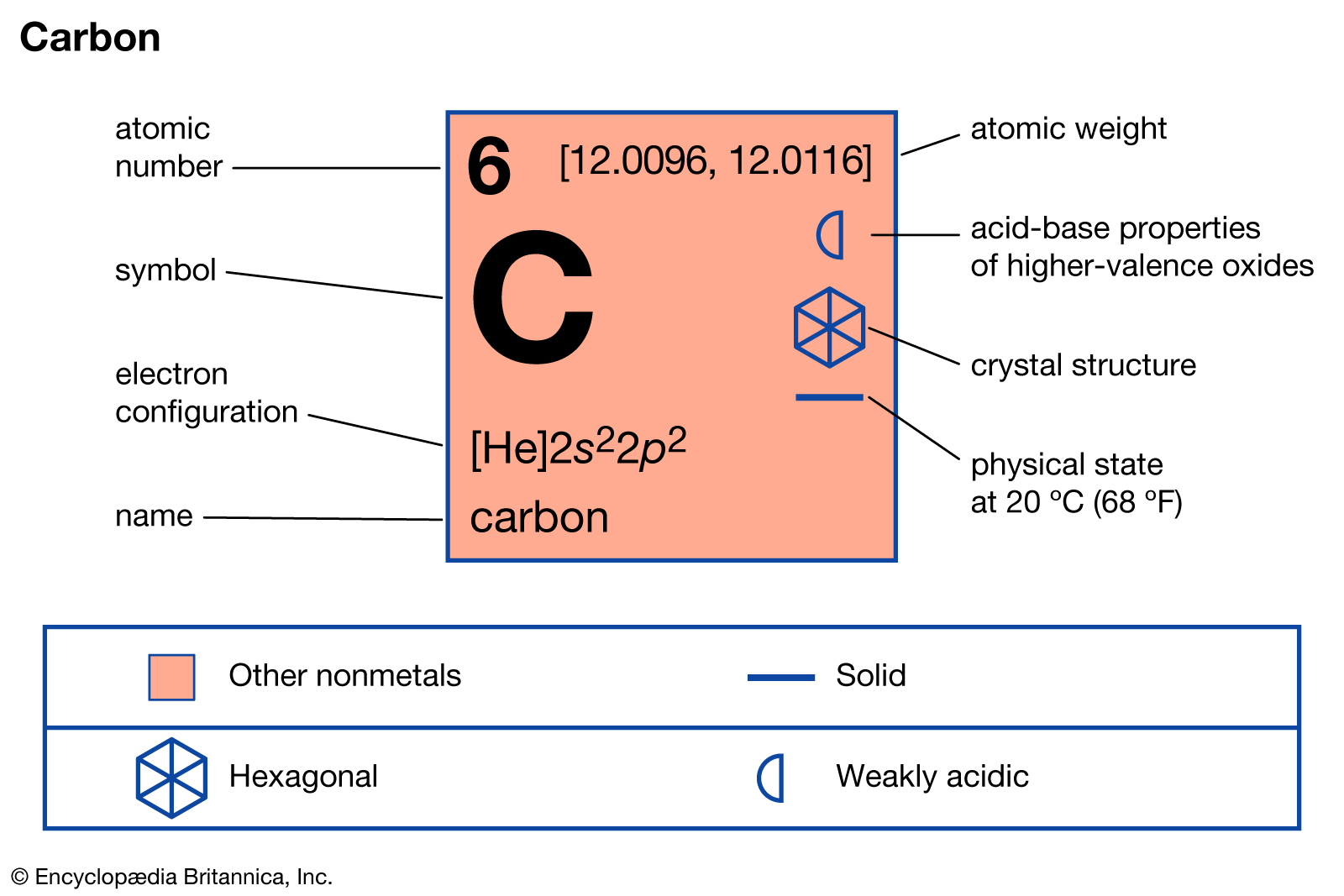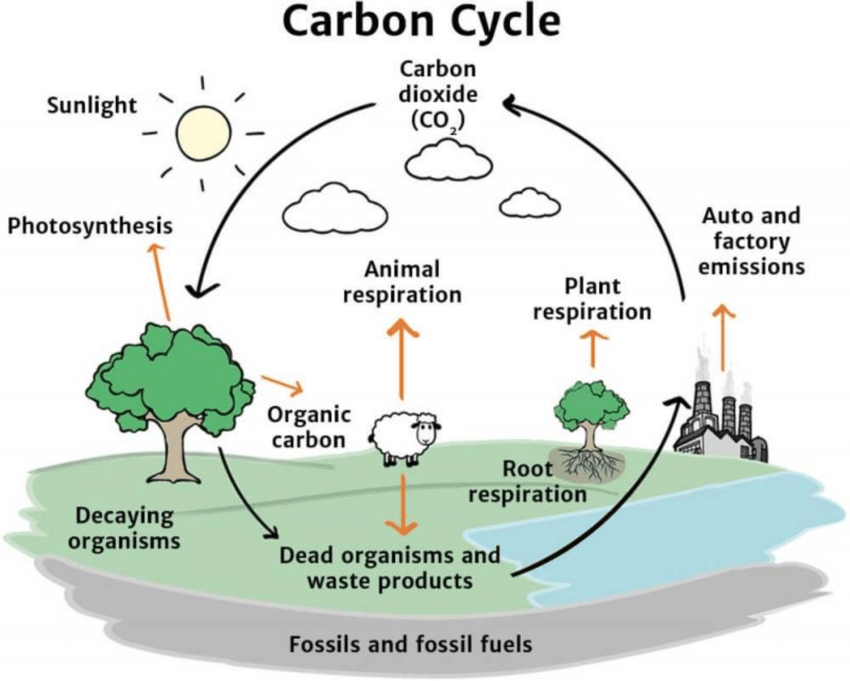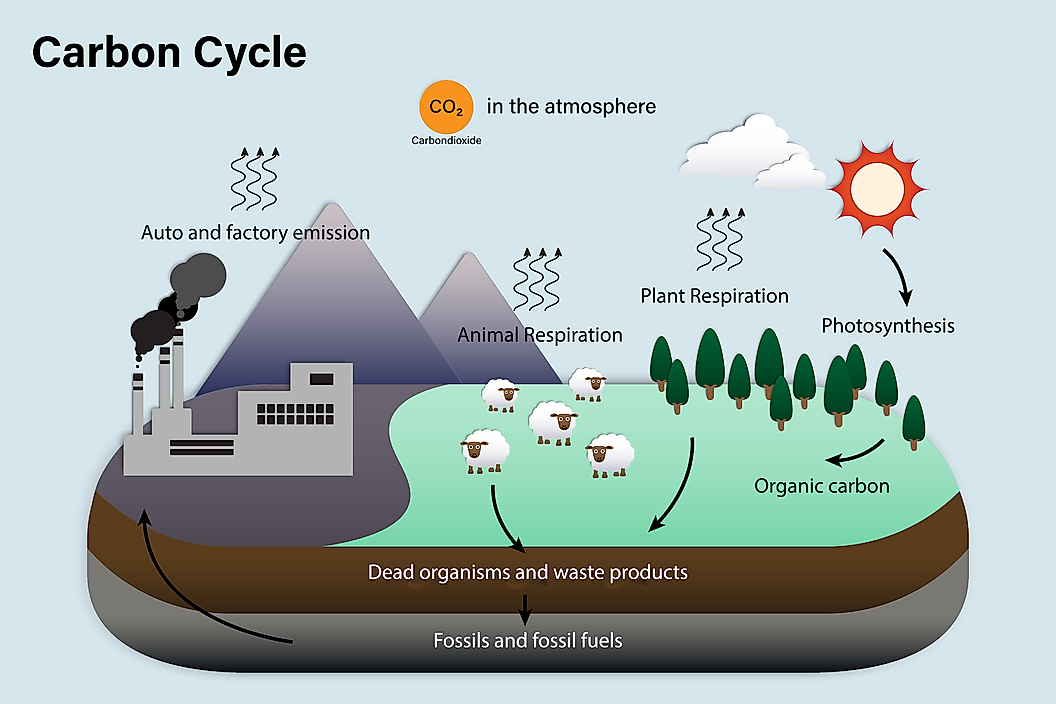Carbon Cycle Study Guide
Check out awesome, educational VR rooms on Inspirit’s mobile app (available for iOS and Android devices)🤩
Introduction:
The carbon cycle in the ecosystem is typically found in CO2 and has several benefits, such as regulating temperature, a key ingredient in food, and a source of energy.
This guide explains the carbon cycle can be provided as the continuous travel of carbon atoms from the atmosphere to earth and back from earth to the atmosphere.
Carbon
Carbon is an atom that is the main foundation or base of life on planet earth. It is an atom that is required for the formation of proteins and DNA which we all know is the main molecule of life. Carbon is also found in the earth’s atmosphere as carbon dioxide. Earth’s temperature is regulated with the help of carbon.
How do we define the Carbon Cycle?
The simple carbon cycle can be defined as a process through which the carbon in the atmosphere gets transferred to the earth, and then the carbon from the earth gets transferred to the atmosphere.
- The carbon on the earth is stored in various forms such as rocks, sediments, the atmosphere, the ocean, and living organisms.
- Through the carbon cycle in nature, the carbon stored is returned to the atmosphere.
- The carbon is returned to the atmosphere through several mechanisms when fossil burns, the eruption of the volcano, blazing of fire, death of organisms, and other ways.
- The carbon in the ocean is exchanged through the carbon cycle process between the surface and the ocean.
Steps
The carbon cycle can be categorized into the following major steps:
-
The plants absorb the carbon in the atmosphere through the process of photosynthesis
-
In the process of the food cycle, the animals consume the plants, and the carbon gets accumulated in the body of the animals.
-
When the plants and animals die, the carbon cycle notes eventually get completed, and the carbon is released back to the atmosphere.
-
The carbon that is not returned to the atmosphere turns into fossil fuels (Animals and plants decompose or turn into fossil fuels).
-
The fossil fuel is then used in various activities by humans, and finally, the entire carbon returns to the atmosphere.
Importance
- Carbon is found in very small traces in the earth’s atmosphere and acts as a blanket against the radiation from the sun.
- If the carbon cycle is disturbed at any point in time, it can result in hazardous consequences such as global warming, climatic changes, and many more.
- It would be an understatement to ask where is carbon found, because carbon is present in every bit of every organism and the atmosphere.
- The carbon element forms an integral part of lipids, proteins, DNA, and other vital elements of the body.
- The existence and survival of life on earth depend upon the oxygen cycle, the carbon cycle, and the nitrogen cycle
Conclusion:
- Carbon is an essential element for every living organism.
- The movement or exchange of carbon between the earth’s atmosphere, hydrosphere, geosphere, and biosphere is explained through the carbon cycle.
- The sedimentary rocks and the formation of fossil fuels are the longer period components of the carbon cycle.
- The availability of other compounds also has an impact on the carbon cycle.
FAQs:
1. What are the 4 steps of the carbon cycle?
The atmosphere contains carbon in the form of CO2This is absorbed by green plants and autotrophsAnimals eat plants, and carbon enters into their systemDecomposition of animals and plants results in the return back of carbon to the environment
2. What are the types of the carbon cycle?
Based on the duration of the process, the carbon cycle can be categorized as:
- Short term: It takes a shorter period such as years or months to complete the carbon cycle, and so it is termed a short term cycle
- Long Term: Under this cycle, it takes thousands of years to complete the carbon cycle, and the carbon is stored in the reservoir for years and years.
3. What is the carbon cycle short answer?
When the different carbon compounds are interchanged and exchanged from the various layers of the earth, including the atmosphere, hydrosphere, pedosphere, geosphere, and biosphere, it is called the carbon cycle.
4. Explain the carbon cycle and why is it important?
The survival and existence of life on earth are based on the carbon cycle. The carbon traps the heat from the sun and acts as insulation. Carbon is an essential building block and provides a stable bond with other elements for the sustainability of life. Thus, the carbon cycle is important from a biological as well as environmental perspective.
5. What is the carbon cycle explained?
The carbon cycle is the process of the exchange of carbon atoms continuously from the atmosphere to the earth’s environment and back to the atmosphere. This cycle goes on for years together and, if disturbed, can cause disaster.
6. What is the carbon cycle called?
The carbon cycle is also called the biological process or organic process.
7. What are the 6 steps of the carbon cycle?
- Carbon transfers from the atmosphere to plants
- Carbon travels from plants to animals
- From animals and plants, it gets transferred to the soil through decomposition.
- It gets exchanged from living things to the atmosphere
- When fossil fuels are burned, carbon gets transferred to the atmosphere
- Carbon also travels from the atmosphere to the oceans.
8. What are the uses of the carbon cycle?
- Regulates earth’s temperature
- Creates food for living beings
- Provides energy through fuels
9. What is the most important part of the carbon cycle?
The carbon cycle is important as it assists in carbon getting exchanged in the environment, atmosphere, and ocean.
10. What are the two crucial functions of the carbon cycle?
- Trapping heat and radiation of the sun
- Balancing energy on the planet
We hope you enjoyed studying this lesson and learned something cool about the Carbon Cycle! Join our Discord community to get any questions you may have answered and to engage with other students just like you! Don’t forget to download our App to experience our fun, VR classrooms – we promise, it makes studying much more fun! 😎
Sources:
- What is the carbon cycle?. https://oceanservice.noaa.gov/facts/carbon-cycle.html. Accessed 2 Dec, 2021.
- Carbon Cycle. https://flexbooks.ck12.org/cbook/ck-12-biology-flexbook-2.0/section/6.6/primary/lesson/carbon-cycle-bio/. Accessed 2 Dec, 2021.
- Carbon Cycle. https://www.worldatlas.com/articles/what-is-the-carbon-cycle.html. Accessed 2 Dec, 2021.



